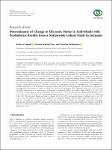Determinants of Change in Glycemic Status in Individuals with Prediabetes: Results from a Nationwide Cohort Study in Germany
Paprott, Rebecca
Scheidt-Nave, Christa
Heidemann, Christin
Previous studies investigating determinants of changes in glycemic status among individuals with prediabetes mainly focused on glucose-defined prediabetes. In this study, we examined determinants of a regression to normoglycemia or a progression to diabetes among individuals with HbA1c-defined prediabetes. The study included 817 participants (18–79 years) with prediabetes (HbA1c 5.7–6.4% (39–47 mmol/mol)) at baseline. Glycemic status at follow-up was categorized as diagnosed diabetes (self-reported physician diagnosis or antidiabetic medication), undiagnosed diabetes (HbA1c ≥ 6.5% (≥48 mmol/mol)), prediabetes (as defined at baseline), and normoglycemia (HbA1c < 5.7% (<39 mmol/mol)). Determinants of glycemic changes were identified by multinomial logistic regression (OR (95% CI)), with those remaining in the prediabetic state as reference. During a mean follow-up time of 12.0 years, 33.8% of the participants reverted to normoglycemia, 7.2% progressed to undiagnosed diabetes, 12.8% progressed to diagnosed diabetes, and 46.2% remained prediabetic. Determinants of a regression to normoglycemia were female sex (male vs. female: 0.67 (0.46; 0.98)) and higher HDL cholesterol levels (1.17 (1.02; 1.35) per 10 mg/dl). Determinants of a progression to undiagnosed or diagnosed diabetes were higher values of BMI (1.10 (1.02; 1.18); 1.13 (1.06; 1.21) per kg/m2), waist circumference (1.04 (1.01; 1.07); 1.06 (1.03; 1.09) per cm), alanine aminotransferase (1.06 (1.03; 1.09); 1.07 (1.03; 1.10) per U/l), and gamma-glutamyl transferase (1.02 (1.00; 1.03); 1.03 (1.01; 1.04) per U/l). Higher age (1.04 (1.02; 1.06) per year), female sex (male vs. female: 0.56 (0.33; 0.97)), and parental history of diabetes (yes vs. no: 1.82 (1.05; 3.15)) were further associated with a progression to diagnosed diabetes, whereas higher triglyceride levels (1.03 (1.01; 1.06) per 10 mg/dl) were associated with a progression to undiagnosed diabetes. In conclusion, among the investigated determinants, potentially modifiable anthropometric and metabolic markers were associated with glycemic changes in individuals with HbA1c-defined prediabetes. The findings of this study demonstrate the need for more refined case finding strategies for diabetes prevention.

